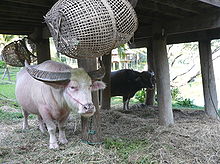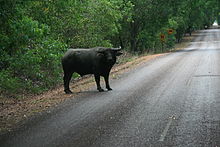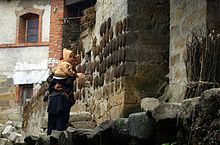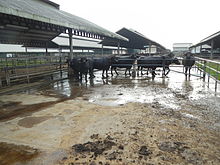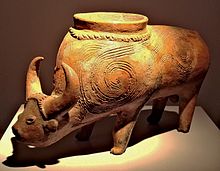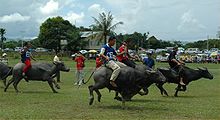
Water buffalo
Did you know...
SOS Children produced this website for schools as well as this video website about Africa. Do you want to know about sponsoring? See www.sponsorachild.org.uk
| Water buffalo | |
|---|---|
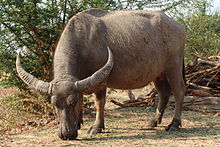 |
|
| Water buffalo cow in Thailand | |
| Conservation status | |
|
Domesticated
|
|
| Scientific classification | |
| Kingdom: | Animalia |
| Phylum: | Chordata |
| Class: | Mammalia |
| Order: | Artiodactyla |
| Family: | Bovidae |
| Subfamily: | Bovinae |
| Tribe: | Bovini |
| Genus: | Bubalus |
| Species: | B. bubalis |
| Binomial name | |
| Bubalus bubalis (Linnaeus, 1758) |
|
|
|
 |
|
| Global distribution of buffaloes in 2004 | |
The water buffalo or domestic Asian water buffalo (Bubalus bubalis) is a large buffalo found on the Indian subcontinent to Vietnam and Peninsular Malaysia, in Sri Lanka and in Borneo. Water buffaloes are especially suitable for tilling rice fields, and their milk is richer in fat and protein than of the dairy cow. The large feral population of northern Australia became established in the late 19th century, and there are smaller feral herds in New Guinea, Tunisia and northeastern Argentina. Two groups have been described termed Swamp and River types. There are at least 130 million domestic water buffalo, and more human beings depend on them than on any other domestic animal.
The wild water buffalo (Bubalus arnee) native to Southeast Asia is considered a different species that is listed as Endangered in the IUCN Red List since 1986, as the remaining global wild population totals less than 4,000 individuals, with an estimate of fewer than 2,500 mature individuals. The population decline of at least 50% over the last 24–30 years is projected to continue. It most likely represents the ancestor of the domestic water buffalo.
Water buffaloes were domesticated in India some 5000 years ago, and in China 4000 years ago. Two types are recognized, based on morphological and behavioural criteria – the river buffalo of the Indian subcontinent and further west to the Balkans and Italy, and the swamp buffalo, found from Assam in the west through Southeast Asia to the Yangtze valley of China in the east. The origin of the domestic water buffalo is still an open question. Results of a phylogenetic study indicate that the swamp water buffalo may have originated in China, while the river water buffalo originated from India.
The ancestry of the African buffalo (Syncerus caffer) is unclear, but it is not closely related to the water buffalo.
Characteristics

Swamp buffaloes have a grey skin at birth but become slate blue later. Albinoids are present in some populations. Swamp buffaloes are heavy-bodied and stockily built, the body is short and the belly large. The forehead is flat, the eyes prominent, the face short and the muzzle wide. The neck is comparatively long, the withers and croup are prominent. A dorsal ridge extends backward and ends abruptly just before the end of the chest. Their horns grow outward, and curve in a semicircle, but always remain more or less on the plane of the forehead. The tail is short, reaching only to the hocks. Height at withers is 129–133 cm (51–52 in) for males, and 120–127 cm (47–50 in) for females. They range in weight from 300–550 kg (660–1,200 lb), but weights of over 1,000 kg (2,200 lb) have also been observed.
Especially in the Tana Toraja Regency, a local variety of water buffalo called tedong bonga features a unique black and white colouration.
The skin of river buffaloes is black, but some specimens may have dark slate-coloured skin. They have comparatively longer faces, smaller girth and bigger limbs than swamp buffaloes. The dorsal ridge extends further back and tapers off more gradually. Their horns grow downward and backward, then curve upward in a spiral.
The swamp buffalo has 48 chromosomes; the river buffalo has 50 chromosomes. The two types do not readily interbreed, but fertile offspring can occur. Buffalo-cattle hybrids have not been observed to occur, and the embryos of such hybrids do not reach maturity in laboratory experiments.
The rumen of the water buffalo has important differences from that of other ruminants. It contains a larger population of bacteria, particularly the cellulolytic bacteria, lower protozoa and higher fungi zoospores. In addition, higher rumen ammonia nitrogen (NH4-N) and higher pH have been found as compared to those in cattle.
Ecology and behaviour
River buffaloes prefer deep water. Swamp buffaloes prefer to wallow in a mudhole that they make with the horns. Their objective is to acquire a thick coating of mud. Both are well adapted to a hot and humid climate with temperatures ranging from 0 °C (32 °F) in the winter to 30 °C (86 °F) and over in the summer. Water availability is of high importance in hot climates since they need wallows, rivers or splashing water in order to reduce the heat load and thermal stress. Some breeds are adapted to saline seaside shores and saline sandy terrain.
Water buffaloes thrive on many aquatic plants and in time of flood will graze submerged, raising their heads above the water and carrying quantities of edible plants. They eat reeds, quassab, a giant reed, birdi, a kind of bulrush, kaulan, water hyacinth and marsh grasses. Some of these plants are of great value to local peoples in many ways; others, such as water hyacinth, are a major problem in some tropical valleys, and water buffaloes may help to keep waterways clear. Green fodders are used widely for intensive milk production and for fattening. Many fodder crops are conserved as hay, chaffed or pulped. Fodders include alfalfa and lucernes, berseem and bancheri, the leaves, stems or trimmings of banana, cassava, fodder beet, halfa, ipil-ipil and kenaf, maize, oats, pandarus, peanut, sorghum, soybean, sugarcane, bagasse and turnips. Citrus pulp and pineapple wastes have been fed safely to buffaloes. In Egypt, whole sun-dried dates are fed to milk buffaloes up to 25% of standard feed mixture.
Reproduction
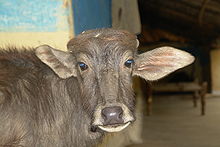
Swamp buffaloes are generally slower than river breeds in arriving at breeding age. Young males in Egypt, India and Pakistan are put to the first service at about 3–3.5 years of age but in Italy they may be used as early as 2 years. Good service behaviour may continue until the animal is 12 years or even older. A good river male can settle 100 females a year. There is a strong seasonal influence on mating. Heat stress reduces libido.
Although buffaloes are poly oestrus, their reproductive efficiency shows wide variation throughout the year. Buffalo cows exhibit a distinct seasonal change in displaying oestrus, conception rate and calving rate.
The average lifespan is up to 25 years.
Taxonomic history
Carl Linnaeus first described the genus Bos and the water buffalo under the binomial Bubalis bubalus in 1758. Latter was known to occur in Asia and as a domestic form in Italy. Ellerman and Morrison-Scott treated the wild and domestic forms of the water buffalo as conspecific. Others treated the wild and domestic water buffaloes as different species. The nomenclatorial treatment of wild and domestic forms has been inconsistent and varied between authors and even within the works of single authors.
In March 2003, the International Commission on Zoological Nomenclature achieved consistency in the naming of wild and domestic water buffaloes by ruling that the scientific name Bubalus arnee is valid for the wild form. Bubalus bubalis continues to be valid for the domestic form and applies also to feral populations.
Domestication and breeding
Water buffaloes were domesticated in India about 5000 years ago, and in China about 4000 years ago. Two types are recognized, based on morphological and behavioural criteria – the river buffalo of the Indian subcontinent and further west to the Balkans and Italy, and the swamp buffalo, found from Assam in the west through Southeast Asia to the Yangtze valley of China in the east. Sequencing of cytochrome b genes of Bubalus species implies that the domestic buffalo originated from at least two populations, and that the river and the swamp types have differentiated at the full species level. The genetic distance between the two types is so large that a divergence time of about 1.7 million years has been suggested. The swamp type was noticed to have the closest relationship with the tamaraw. Results of mitochondrial DNA analyses indicate that the two types were domesticated independently.
The present day river buffalo is the result of complex domestication processes involving more than one maternal lineage and a significant maternal gene flow from wild populations after the initial domestication events. There are 22 breeds of the river type water buffalo known including Murrah, Nili-Ravi, Surti, Jafarabadi, Anatolian and Egyptian. China has a huge variety of buffalo genetic resources. Each region has different types of buffaloes; 16 local swamp buffalo breeds are known.
Distribution of populations
The water buffalo population in the world is about 168 million head.
In Asia

More than 95.8% of the world population of water buffaloes can be found in Asia including both river and swamp types. The water buffalo population in India numbered over 97.9 million head in 2003 representing 56.5 % of the world population. They are primarily of the river type with 10 well-defined breeds comprising Badhawari, Murrah, Nili-Ravi, Jafarabadi, Marathwada, Mehsana, Nagpuri, Pandharpuri, Toda and Surti. Swamp buffaloes occur only in small areas in the north-eastern part of the country and are not distinguished into breeds.
The second largest population lives in China with 22.759 million heads in 2003. They are all of the swamp type with breeds that can be found only in the lowlands, and other breeds that live only in the mountains. The water buffalo is the main dairy animal in Pakistan with 22 million head, of which 76% are found in the Punjab. There are 3.2 million swamp type Carabao buffaloes in the Philippines, and nearly three million swamp buffaloes in Vietnam. Bangladesh had 772,764 buffalo head in 2003, and about 750,000 head were estimated in Sri Lanka in 1997.
In Europe and the Mediterranean
It is generally considered that water buffaloes were introduced to Europe from India or other Oriental countries. To Italy they were introduced about the year 600 in the reign of the Longobardian King Agilulf. As they appear in the company of wild horses, it seems probable that they were a present from the Khan of the Avars, a Turkish nomadic tribe that dwelt near the Danube River at the time. Sir H. Johnston knew of a herd of water buffaloes presented by a King of Naples to the Bey of Tunis in the mid 19th century that had resumed the feral state in northern Tunis.
European buffaloes are all of the river type and considered to be of the same breed named the Mediterranean. In Italy the Mediterranean type was particularly selected and is called Mediterranean Italian breed to distinguish it from other European breeds, which are not at the same genetic level. Herds can also be found in Romania, Bulgaria, Greece, Albania, Kosovo and TFYR Macedonia, and a few hundred in the United Kingdom, Germany, the Netherlands, Switzerland and Hungary. There has been little exchange of breeding buffaloes among countries, therefore each population has its own phenotypic traits and performances. In Bulgaria, crossbreeding with the Indian Murrah breed was undertaken. Some water buffaloes in Romania have been crossbred with Bulgarian Murrah. Populations in Turkey are of the Anatolian buffalo breed.
In Australia
Between 1824 and 1849, water buffalos were introduced into the Northern Territory from Timor, Kisar and probably other islands in the Indonesian archipelago. In 1886, a few milking types were brought from India to Darwin. They have been the main grazing animals on the sub-coastal plains and river basins between Darwin and Arnhem Land since the 1880s. In the early 1960s, an estimated population of 150,000 to 200,000 buffalos were living in the plains and nearby areas.
They became feral and caused causing significant environmental damage. Buffalo are also found in the Top End. As a result, they were hunted in the Top End from 1885 until 1980. The commencement of the Brucellosis and Tuberculosis Campaign (BTEC) resulted in a huge culling program to reduce buffalo herds to a fraction of the numbers that were reached in the 1980s. The BTEC was finished when the Northern Territory was declared free of the disease in 1997. During the 1950s, buffalo were hunted for their skins and meat, which was exported and used in the local trade. In the late 1970s, live exports were made to Cuba and continued later into other countries. Buffalo are now crossed with riverine buffalo in artificial breeding (AI) programs, and may be found in many areas of Australia. Some of these crossbreds are used for milk production. Melville Island is a popular hunting location, where a steady population of up to 4,000 individuals exist. Safari outfits are run out of Darwin to Melville Island and other locations in the Top End, often with the use of bush pilots. The horns, which can measure up to a record of 3.1 metres tip-to-tip, are prized hunting trophies.
The buffalo have developed a different appearance from the Indonesian buffalo from which they descend. They live mainly in freshwater marshes and billabongs, and their territory range can be quite expansive during the wet season. Their only natural predators in Australia are large adult saltwater crocodiles, with whom they share the billabongs, and dingoes, which have been known to prey on buffalo calves and occasionally adult buffalos when the dingoes are in large packs.
In South America
Water buffalo were introduced into the Amazon River basin in 1895. They are now extensively used there for meat and dairy production. In 2005, the buffalo herd in the Brazilian Amazon stood at approximately 1.6 million head, of which approximately 460,000 were located in the lower Amazon floodplain. Breeds used include Mediterranean from Italy, Murrah and Jafarabadi from India, and Carabao from the Philippines.
In Argentina, many game ranches raise water buffalo for commercial hunting.
In North America
One of the first milking herds in North America was in Canada at Fairburn Water Buffalo on Vancouver Island. The farm is owned and operated by Darrel, Anthea, Maryann, and Richard Archer. The Archers started milking in 2006 with Murrah Water Buffalo imported from Bulgaria. The milk is made into fresh Mozzarella cheese by Natural Pastures Cheese Company. There are now several dairy farms on Vancouver Island as well as farms in Alberta, Ontario, and Quebec. Vermont Water Buffalo Inc., known as bufala di vermont, is a water buffalo farm and creamery located in South Woodstock, Vermont.
There are very limited commercial herds in the USA, for yogurt and cheese products. In Gainesville, Florida, a University of Florida professor, Hugh Popenoe, has raised water buffalo from young obtained from zoo overflow. He uses them primarily for meat production (frequently sold as hamburger), although other local ranchers use them for production of high-quality mozzarella cheese.
Husbandry

Water buffaloes are classic work animals in Asia, and an integral part of the traditional village farming structure. They are used for pumping water in Pakistan, hauling logs in Turkey, and hauling cotton and other bulk crops. They is often referred to as “the living tractor of the East”, as they are relied upon for ploughing and transportation in many parts of Asia. Their dung is used as a fertilizer, and as a fuel when dried. A few have also found use as pack animals, carrying loads even for special forces. Water buffalo hide provides tough and useful leather, often used for shoes and motorcycle helmets.
Moreover, they are much better suited to plough the muddy paddy fields, as they are better adapted than common cattle (Bos taurus) to move in swamps. It is valuable for its meat and milk, as well as the labour it performs. Buffalo milk has the lowest water content and highest fat content amongst farm animals, and the butterfat is a major source of ghee in some Asian countries. Part of their success is due to their ability to thrive on poor foodstuffs and yet be valuable economically.
Buffalo meat, sometimes called "carabeef", is often passed off as beef in certain regions, and is also a major source of export revenue for India, which has the largest population of buffalo in the world. In many Asian regions, buffalo meat is less preferred due to its toughness; however, recipes have evolved ( rendang, for example) where the slow cooking process and spices not only makes the meat palatable, but also preserves it, an important factor in hot climates where refrigeration is not always available.
The bones and horns are often made into jewellery, especially earrings. Horns are used for the embouchure of musical instruments, such as ney and kaval.
Buffaloes contribute 72 million tones of milk and three million tones of meat annually to world food, much of it in areas that are prone to nutritional imbalances. In India river type buffaloes are kept mainly for milk production and for transport, whereas swamp type buffaloes are kept mainly for work and a very small amount of milk.
Dairy products
Water buffalo milk presents physicochemical features different from that of other ruminant species, such as a higher content of fatty acids and proteins. The physical and chemical parameters of swamp and river type water buffalo milk differs. Water buffalo milk contains higher levels of total solids, crude protein, fat, calcium, phosphorous and slightly higher content of lactose compared with those of cow milk. The high level of total solids makes water buffalo milk ideal for processing into value added dairy products such as cheese. The conjugated linoleic acid (CLA) content in milk ranged from 4.4 mg/g fat in September to 7.6 mg/g fat in June. Seasons and genetics may play a role in variation of CLA level and changes in gross composition of the water buffalo milk.
Water buffalo milk is processed into a large variety of dairy products:
- cream churns much faster at higher fat levels and gives higher overrun than cow cream;
- butter from water buffalo cream displays more stability than that from cow cream;
- ghee from water buffalo milk has a different texture with a bigger grain size than ghee from cow milk;
- heat-concentrated milk products in India include paneer, khoa, rabri, kheer and basundi;
- fermented milk products include dahi, yoghurt, chakka;
- whey is used for making Ricotta and Mascarpone in Italy, and Alkarish in Syria and Egypt;
- soft cheeses include Mozzarella in Italy, Karish, Mish and Domiati in Egypt, Madhfor in Iraq, Alghab in Syria, Vladeasa in Romania;
- the semi-hard cheese Beyaz peyneri is made in Turkey;
- hard cheeses include Braila in Romania, Rahss in Egypt, White brine in Bulgaria and Akkawi in Syria;
| Top ten buffalo milk producers — 11 June 2008 | ||||
|---|---|---|---|---|
| Country | Production ( tonnes) | Footnote | ||
| 56 960 000 | Unofficial, Semi-official, mirror data | |||
| 21 500 000 | official figure | |||
| 2 900 000 | FAO estimate | |||
| 2 300 000 | FAO estimate | |||
| 930 000 | FAO estimate | |||
| 241 500 | FAO estimate | |||
| 205 000 | FAO estimate | |||
| 200 000 | FAO estimate | |||
| 35 100 | FAO estimate | |||
| 31 000 | FAO estimate | |||
| World | 85 396 902 | |||
Environmental effects
The water buffalo may affect the environment in either positive or negative ways.
Wildlife and conservation scientists have started to recommend and use introduced populations of feral domestic water buffalo in far away lands to manage uncontrolled vegetation growth in and around natural wetlands. Introduced water buffalo at home in such environs provide cheap service by regularly grazing the uncontrolled vegetation and opening up clogged water bodies for waterfowl, wetland birds and other wildlife. Grazing water buffalo are sometimes used in Great Britain for conservation grazing, for example to manage Chippenham Fen NNR. These buffalo have been found to be better suited to the wet conditions and poor-quality vegetation than many cattle.
Currently, research is being conducted at the Lyle Centre for Regenerative Studies to determine the levels of nutrients removed and returned to wetlands when water buffalo are used for wetland vegetation management.
However, in uncontrolled circumstances, water buffalo can cause environmental damage, such as trampling vegetation, disturbing bird and reptile nesting sites, and spreading exotic weeds.
Research
The world's first cloned buffalo was developed by Indian scientists from National Dairy Research Institute, Karnal. The buffalo calf was named Samrupa. The calf did not survive more than a week, and died due to some genetic disorders. So, the scientists created another cloned buffalo a few months later, and named it Garima.
On 15 September 2007, the Philippines announced its development of Southeast Asia's first cloned buffalo. The Philippine Council for Agriculture, Forestry and Natural Resources Research and Development (PCARRD), under the Department of Science and Technology in Los Baños, Laguna approved this project. The Department of Agriculture's Philippine Carabao Centre (PCC) will implement "Cloning through somatic cell nuclear transfer as a tool for genetic improvement in water buffaloes". "Super buffalo calves" will be produced. There will be no modification or alteration of the genetic materials, as in genetically modified organisms (GMOs).
On 1 January 2008, the Philippine Carabao Centre in Nueva Ecija, per Filipino scientists, initiated a study to breed a super water buffalo that could produce 4 to 18 litres of milk per day using gene-based technology. Also, the first in vitro river buffalo was born there in 2004 from an in vitro-produced, vitrified embryo, named "Glory" after President Gloria Macapagal-Arroyo. Joseph Estrada's most successful project as an opposition senator, the PCC was created through Republic Act 3707, the Carabao Act of 1992.
In culture
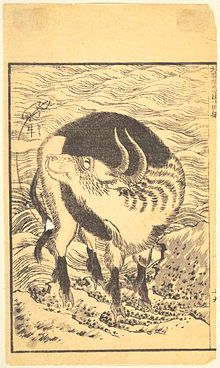
Some ethnic groups, such as Batak and Toraja in Indonesia and the Derung in China, use water buffalo or kerbau (called horbo in Batak or tedong in Toraja) as sacrificial animals at several festivals.
- Legend has it that the Chinese philosophical sage Laozi left China through the Han Gu Pass riding a water buffalo.
- According to Hindu lore, the god of death Yama, rides on a male water buffalo.
- The carabao subspecies is considered a national symbol in the Philippines.
- In Vietnam, water buffalo are often the most valuable possession of poor farmers: "Con trâu là đầu cơ nghiệp". They are treated as a member of the family: "Chồng cày, vợ cấy, con trâu đi bừa" ("The husband ploughs, the wife sows, water buffalo draws the rake") and are friends of the children. Children talk to their water buffalo, "Bao giờ cây lúa còn bông. Thì còn ngọn cỏ ngoài đồng trâu ăn." (Vietnamese children are responsible for grazing water buffalo. They will feed them a lot of grass if they work laboriously for men.) In the old days, West Lake, Hà Nội was named Kim Ngưu - Golden Water Buffalo.
- The Yoruban Orisha Oya (goddess of change) takes the form of a water buffalo.
Fighting festivals
- Moh juj Water Buffalo fighting is held every year in Bhogali Bihu in Assam. Ahotguri in Nagaon is famous for it.
- The Do Son Water Buffalo Fighting Festival of Vietnam, held each year on the ninth day of the eighth month of the lunar calendar at Do Son Township, Haiphong City in Vietnam, is one of the most popular Vietnam festivals and events in Haiphong City. The preparations for this buffalo fighting festival begin from the two to three months earlier. The competing buffalo are selected and methodically trained months in advance. It is a traditional festival of Vietnam attached to a Water God worshipping ceremony and the Hien Sinh custom to show martial spirit of the local people of Do Son, Haiphong.
- "Hai Luu" Water Buffalo Fighting Festival of Vietnam According to ancient records, the buffalo fighting in Hai Luu Commune has existed from the 2nd century B.C. General Lu Gia at that time, had the buffalo slaughtered to give a feast to the local people and the warriors, and organized buffalo fighting for amusement. Eventually, all the fighting buffalo will be slaughtered as tributes to the deities.
- "Ko Samui" Water Buffalo Fighting Festival of Thailand is a very popular event held on special occasions such as New Year's Day in January, and Songkran in mid-April, this festival features head-wrestling bouts in which two male Asian water buffalo are pitted against one another. Unlike in Spanish Bullfighting, wherein bulls get killed while fighting sword-wielding men, Buffalo Fighting Festival held at Ko Samui, Thailand is fairly harmless contest. The fighting season varies according to ancient customs & ceremonies. The first Buffalo to turn and run away is considered the loser, the winning buffalo becomes worth several million baht. Ko Samui is an island in the Gulf of Thailand in the South China Sea, it is 700 km from Bangkok and is connected to it by regular flights.
- "Ma'Pasilaga Tedong" Water Buffalo Fighting Festival in Tana Toraja Regency of Sulawesi Island, Indonesia is a very popular event where the Rambu Solo' or a Burial Festival took place in Tana Toraja. It is very attractive moment before the buffalo are being sacrified.
Racing festivals
- Kambala races, Karnataka, India: The Kambala water buffalo races of Karnataka, India take place between December and March. The races are conducted by having the water buffalo (he buffalo) run in long parallel slushy ditches, where they are driven by men standing on wooden planks drawn by the buffaloes. The objectives of the race are to finish first and to raise the water to the greatest height and also a rural sport. Kambala races are arranged with competition as well as without competition and as a part of thanks giving (to god) in about 50 villages of coastal Karnataka.
- In the Chonburi Province of Thailand, and in Pakistan, there are annual water buffalo races.
- Chon Buri Water buffalo racing festival, Thailand: Thousands of people flock to this entertainment in downtown Chonburi, 70 km (43 mi) south of Bangkok, at the annual water buffalo festival. About 300 buffalo race in groups of five or six, spurred on by bareback jockeys wielding wooden sticks, as hundreds of spectators cheer. The water buffalo has always played an important role in agriculture in Thailand. For farmers of Chon Buri Province, near Bangkok, it is an important annual festival, beginning in mid-October. It is also a celebration among rice farmers before the rice harvest. At dawn, farmers walk their buffalo through surrounding rice fields, splashing them with water to keep them cool before leading them to the race field. This amazing festival started over a hundred years ago when two men arguing about whose buffalo was the fastest ended up having a race between them. That’s how it became a tradition and gradually a social event for farmers who gathered from around the country in Chonburi to trade their goods. The festival also helps a great deal in preserving the number of buffalo, which have been dwindling at quite an alarming rate in other regions. Modern machinery is rapidly replacing buffalo in Thai agriculture. With most of the farm work mechanized, the buffalo-racing tradition has continued. Racing buffalo are now raised just to race; they do not work at all. The few farm buffalo which still do work are much bigger than the racers because of the strenuous work they perform. Farm buffalo are in the “Buffalo Beauty Pageant”, a Miss Farmer beauty contest and a comic buffalo costume contest etc.. This festival perfectly exemplifies a favored Thai attitude to life — "sanuk," meaning fun.
- Babulang Water buffalo racing festival, Sarawak, Malaysia: Babulang is the largest or grandest of the many rituals, ceremonies and festivals of the traditional Bisaya (Borneo) community of Limbang, Sarawak. Highlights are the Ratu Babulang competition and the Water buffalo races which can only be found in this town in Sarawak, Malaysia.
- Vihear Suor village Water buffalo racing festival, Cambodia: Each year, millions of Cambodians visit Buddhist temples across the country to honour their deceased loved ones during a 15-day period commonly known as the Festival of the Dead but in Vihear Suor village, about 22 miles (35 km) northeast of the capital of Cambodia, Phnom Penh, citizens each year wrap up the festival with a water buffalo race to entertain visitors and honour a pledge made hundreds of years ago. There was a time when many village cattle which provide rural Cambodians with muscle power to plough their fields and transport agricultural products died from an unknown disease. The villagers prayed to a spirit to help save their animals from the disease and promised to show their gratitude by holding a buffalo race each year on the last day of “P'chum Ben” festival as it is known in Cambodian. The race draws hundreds of spectators who come to see riders and their animals charge down the racing field, the racers bouncing up and down on the backs of their buffalo, whose horns were draped with colorful cloth.
- Karapan Sapi racing festival, Madura, Indonesia: The Maduranese people of the island of Madura, East Java, Indonesia, race their strongest and fastest buffalo in races hold regularly a few times a year, typically in August, September and October. It is a very popular spectacle in the towns of Pamekasan, Sampang, and Bangkalan. Besides the prize (and the pride that comes with it), buffalo that win a race are regarded very valuable and are a lot more expensive than their peers. This motivates the owners to feed their buffalo unusual cocktails of high calorie food composed of raw eggs, honey, and herbs, in addition to their regular training regimen, to give them the edge.
- Pottu puttu matsaram, Kerala, South India: Similar to Kambala races.

